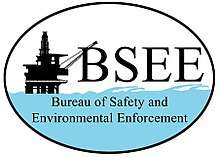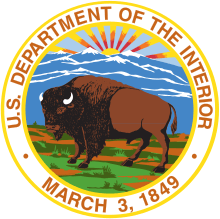Bureau of Safety and Environmental Enforcement
The Bureau of Safety and Environmental Enforcement (BSEE /ˈbɛsi/ "Bessie") is an agency under the United States Department of the Interior.[1] Established in 2011, BSEE is the lead agency in charge of improving safety and ensuring environmental protection relating to the offshore energy industry, mainly natural gas and oil, on the United States Outer Continental Shelf (OCS).[2] The agency exercises the safety and environmental enforcement functions formerly under the Minerals Management Service including the authority to inspect, investigate, summon witnesses and produce evidence, levy penalties, cancel or suspend activities, and oversee safety, response, and removal preparedness.[1]
 | |
| Agency overview | |
|---|---|
| Formed | October 1, 2011 |
| Preceding agency | |
| Headquarters | Main Interior Building Washington, D.C. |
| Employees | 881 FTE (2016) |
| Annual budget | $204.6 million USD (2016) |
| Agency executive |
|
| Parent agency | Department of the Interior |
| Website | www.bsee.gov |
History
The BSEE was established in response to the regulatory failure of Minerals Management Service (MMS) in the Deepwater Horizon oil spill of 2010. Secretarial Order 3299 signed by then Secretary of the Interior Ken Salazar on May 19, 2010, created the agency. Order 3299 also created the Bureau of Ocean Energy Management (BOEM) and the Office of Natural Resources Revenue (ONRR).[1]
The creation of the three independent entities was designed to carry out three missions:[3]
- Ensuring the balance and responsible development of energy resources on the Outer Continental Shelf (OCS)
- Ensuring safe and environmentally responsible exploration and production and enforcing applicable rules and regulations
- Ensuring a fair return to the taxpayer from offshore royalty and revenue collection and disbursement activities
On June 18, 2010, Secretarial Order 3302 briefly renamed the MMS to the Bureau of Ocean Energy Management, Regulation and Enforcement (BOEMRE). This name was in effect until the official establishment of the BSEE on October 1, 2011.[4] On September 16, 2011, Salazar named former MMS Director Michael R. Bromwich as the BSEE's first director.[5] On November 14, 2011, Salazar named Coast Guard Rear Admiral James A. Watson as the BSEE's second director.[6]
On August 14, 2013, Interior Secretary Sally Jewell named former Coast Guard Vice Admiral Brian Salerno as the BSEE's third director.[7] In 2013, the BSEE and the U.S. Department of Transportation Statistics (BTS) signed an Interagency Agreement (IAA) to create SafeOCS, for voluntary confidential reporting of ‘near misses’ happening on Outer Continental Shelf. It was later expanded to include mandatory reporting of equipment failure data as required in 30 CFR 250.730 and 30 CFR 250.803.[8]
In 2016, the BSEE finalized Well Control Rule. Phased in over time (starting on July 28, 2016), the reform will establish regulations to prevent another Deepwater Horizon tragedy and other well control incidents. In addition, it will implement new and revised industry standards as well as codification of decades worth of BSEE policies.[9]
Key points of Well Control Rule:[10]
- Incorporate industry standards as baseline
- Establish criteria for maintenance and repair of blowout preventers (BOP)
- Safe drilling practices and procedures
- Real time monitoring requirements
- Third party certification programs
In 2016, NASA and the BSEE entered into a five-year interagency agreement (IAA). Under the agreement, NASA will assist BSEE in further developing risk management using NASA's probabilistic risk assessment (PRA) technique.[11] In February 2016, the Government Accountability Office determined that the reorganization had made only limited progress in enhancing BSEE's investigative and enforcement capabilities.[12] In March 2017, the GAO determined that BSEE had not successfully implemented its strategic or management initiatives.[13]
On May 23, 2017, Interior Secretary Ryan Zinke named former Louisiana interim-Lieutenant Governor Scott Angelle as the BSEE's fourth director.[14]
Divisions
Office of Offshore Regulatory Programs (OORP)
The Office of Offshore Regulatory Programs (OORP) manages rules, standards and compliance programs in charge of oil, gas and mineral operations on the Outer Continental Shelf. Branches under the OORP are responsible for regulations and associated policy documents of the OCS. Additionally, programs cover safety management, pollution prevention research, technology assessments, inspection policies and development of BSEE's technical training.[15]
Oil Spill Preparedness Division (OPSD)
The BSEE oversees oil spill planning and preparedness for oil and gas production facilities in U.S. waters (see 30 CFR part 254). Some of the main functions of its Oil Spill Preparedness Division (OSPD) division include the approval of oil spill response plans; inspection of oil spill response equipment; conducting oil spill response research, auditing responder and management team training and exercises. OSPD currently manages the Ohmsett National Spill Response Test Facility, located in Leonardo, New Jersey.[16]
Environmental Compliance Division (ECD)
The Environmental Compliance Division (ECD) monitors, verifies and enforces the offshore industry's compliance with environmental standards in operations on the Outer Continental Shelf (OCS). ECD is responsible for compliancy with the National Environmental Policy Act (NEPA) in regards to BSEE's OCS operations. Other responsibilities include coordination with the Bureau of Ocean Energy Management (BOEM) and other Federal, State and local agencies; and public outreach regarding environmental compliance. Engineers and scientists working under the ECD, are BSEE's national coordinators for various environmental programs including Air Quality, Archaeological and Cultural Resources; Marine Ecology, Marine Trash and Debris Oversight; and the Rigs-to-Reefs (R2R) Artificial Reef Program[17]
Safety & Incident Investigation Division (SIID)
The Safety and Incident Division (SIID) is responsible for establishing national policies relating to the conduct of investigations of safety incidents happening on the OCS. This division also establishes national policies regarding investigator training.[18] SIID at the BSEE headquarters in Washington D.C., manages the National Investigations Program and coordinates the training for investigators and provides support to the regional and district levels.[19]
Budget
As of 2016, the BSEE has a $204.6 million budget and 881 full-time employees (FTE), requesting $204.8 million and no increase in FTE for fiscal year 2017.[20]
Offices
Regional offices are in Anchorage, Alaska; Camarillo, California; New Orleans, Louisiana and district offices along the Gulf of Mexico coast.[21]
Publications
BSEE Annual Reports
Annual reports from The Bureau of Safety and Environmental Enforcement (BSEE) have been issued since 2014. This report highlights the achievements of the agency, its plans for the future and statistics of safety incidences.
BSEE FY Greenbook
The BSEE Greenbook is the United States Department of the Interior's (DOI) budget justifications for the upcoming fiscal year.
Notice to Lessees (NTLs) & Letter to Lessees (LTLs)
NTLs and LTLs are formal documents that clarify, describe and interpret BSEE regulations or Outer Continental Shelf (OCS) standards. They give guidelines in implementation of lease stipulations or regional requirements and explain the scope and meaning of a regulation. NTLs also may communicate administrative information including current telephone numbers and changes in addresses of BSEE offices or personnel. NTLs and LTLs are currently archived on the BSEE’s website.[22]
BSEE Data Center
The BSEE maintains a database containing public information on various topics including leasing information, pipelines, permitting, platform/rig and production information; and statistics. Data is available in the form of online queries, PDFs, ASCII files and scanned documents. Information may be cross-referenced among different subject headings.[23]
See also
References
- Salazar, Ken (May 19, 2010), Secretarial Order Nº 3299 (PDF), retrieved May 21, 2010
- "About Us | Bureau of Safety and Environmental Enforcement". www.bsee.gov. Retrieved 2017-04-22.
- "Reorganization | Bureau of Safety and Environmental Enforcement". www.bsee.gov. Retrieved 2017-04-22.
- Salazar, Ken (June 18, 2010). "Secretarial Order No. 3302". Retrieved 2017-05-02.
- Press Release (16 September 2011). "Secretary Salazar Names Michael R. Bromwich and Tommy P. Beaudreau to Lead New DOI Bureaus". Bureau of Safety and Environmental Enforcement. Retrieved 25 March 2018.
- Press Release (14 November 2011). "Secretary Salazar Names Rear Admiral James A. Watson as New Director of the Bureau of Safety and Environmental Enforcement". United States Department of the Interior. Retrieved 25 March 2018.
- Press Release (14 August 2013). "Secretary Jewell Names Former USCG Vice Admiral Brian Salerno Director of the Bureau of Safety and Environmental Enforcement". United States Department of the Interior. Retrieved 25 March 2018.
- "Near-Miss Reporting System". www.safeocs.gov. Retrieved 2017-04-22.
- "Well Control Rule | Bureau of Safety and Environmental Enforcement". www.bsee.gov. Retrieved 2017-04-22.
- "Well Control Rule Interpretation Workshop Presentation" (PDF). BSEE. August 17, 2016. Retrieved April 21, 2017.
- Canales, Christina (March 17, 2016). "NASA, BSEE Announce Agreement to Examine Risk Offshore". NASA. Retrieved April 21, 2017.
- GAO, Oil and Gas Management: Interior’s Bureau of Safety and Environmental Enforcement Has Not Addressed Long-Standing Oversight Deficiencies, GAO-16-245 (Washington, D.C.: Feb. 10, 2016).
- GAO, Oil and Gas Management: Stronger Leadership Commitment Needed at Interior to Improve Offshore Oversight and Internal Management, GAO-17-293 (Washington, D.C.: Mar. 21, 2017).
- Press Release (22 May 2017). "Former Louisiana State Official Scott A. Angelle Named as Director of the Bureau of Safety and Environmental Enforcement". Bureau of Safety and Environmental Enforcement. Retrieved 25 March 2018.
- "Offshore Regulatory Programs | Bureau of Safety and Environmental Enforcement". www.bsee.gov. Retrieved 2017-05-06.
- "Oil Spill Preparedness | Bureau of Safety and Environmental Enforcement". www.bsee.gov. Retrieved 2017-05-06.
- "Environmental Focuses | Bureau of Safety and Environmental Enforcement". www.bsee.gov. Retrieved 2017-05-06.
- Department of Interior (October 23, 2015). "Department Manual". Department of Interior. Retrieved May 2, 2017.
- "Incident Investigations | Bureau of Safety and Environmental Enforcement". www.bsee.gov. Retrieved 2017-05-06.
- BSEE (July 28, 2016). "Budget Justifications and Performance Information FY 2017 BSEE" (PDF). Department of Interior. Retrieved 16 April 2017.
- "Bureau of Safety and Environmental Enforcement Regional Offices". Department of Interior. n.d. Retrieved 5 May 2017.
- "Notice to Lessees (NTLs) | Bureau of Safety and Environmental Enforcement". www.bsee.gov. Retrieved 2017-04-22.
- "BSEE Data Center". www.data.bsee.gov. Retrieved 2017-05-09.
Further reading
- Committee on the Effectiveness of Safety and Environmental Management Systems for Outer Continental Shelf Oil and Gas (2012). Evaluating the effectiveness of offshore safety and environmental management systems. Washington, D.C: Transportation Research Board. ISBN 9780309223089.
- Hogue, Henry (2010). "Reorganization of the Minerals Management Service in the Aftermath of the Deepwater Horizon Oil Spill" (PDF). Federation of American Scientists Website. Congressional Research Service. Retrieved 23 April 2017.
- National Academy of Engineering; National Research Council; Marine Board; Committee on Options for Implementing the Requirement of Best Available and Safest Technologies for Offshore Oil and Gas Operations (2013). Best available and safest technologies for offshore oil and gas operations : options for implementation. Washington, D.C.: National Academies Press. ISBN 9780309294270.CS1 maint: multiple names: authors list (link)
- Study Team of the National Academy of Public Administration. "Bureau of Safety and Environmental Enforcement: Strategic Organizational Assessment" (PDF). National Academy of Public Administration. Archived from the original (PDF) on 8 June 2017. Retrieved 23 April 2017.
